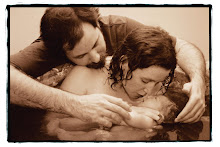
little actions, big payoffs
Often we do things a certain way because, well, that's the way we do them. We have good reasons and don't really question whether there is a better way. But maybe we should...
An example: after a baby is born in a hospital (where most babies in the US are born), the baby might be put on its mom's chest for a minute, though usually on a blanket. That blanket is used to dry off & stimulate babies. That makes sense, though I know plenty of midwives who feel we overdo the stimulating via drying.
But soon after, usually while the birth of the placenta is being medically managed (which is what usually happens in a hospital birth & may be wise - read more here***), the baby is taken to a corner of the room & looked over & then wrapped up and given a hat before being handed back to the mom. A baby burrito...cute, but should we be doing this?
Randomized studies detailed in The Cochrane Library say no...you can read the whole abstract, or this plain language summary (the bolding of the conclusion is mine):
If you are pregnant or if you work with birthing women and new babies, think about this and really consider making skin-to-skin happen if at all possible. Certainly any skin-to-skin, at any time in the early days or weeks is important...but we do not get these first moments and hours back.
Early skin-to-skin contact for mothers and their healthy newborn infants
Skin-to-skin contact between mother and baby at birth reduces crying, improves mother-baby interaction, keeps the baby warmer, and helps women breastfeed successfully.
In many cultures, babies are generally cradled naked on their mother's bare chest at birth. Historically, this was necessary for the baby's survival. In recent times, in some societies as more babies are born in hospital, babies are separated or dressed before being given to their mothers. It has been suggested that in industrialized societies, hospital routines may significantly disrupt early mother-infant interactions and have harmful effects. The review was done to see if there was any impact of early skin-to-skin contact between the mother and her newborn baby on infant health, behavior and breastfeeding. The review included 30 studies involving 1925 mothers and their babies. It showed that babies interacted more with their mothers, stayed warmer, and cried less. Babies were more likely to be breastfed, and to breastfeed for longer, if they had early skin-to-skin contact. Babies were also, possibly, more likely to have a good early relationship with their mothers, but this was difficult to measure.
***regarding the medically managed third stage, I wish the study/ies had looked at whether it contributed to issues with retained membranes, need for D&Cs, related complications and extended lochia (bleeding for the weeks following birth)













1 comment:
I study psychology and studying the evolution on a person from prenatal life till death I have seen in different books that the skin to skin contact does help in stopping the bleeding that may follow in the weeks after birth. It also helps in the process of lactation.
Post a Comment